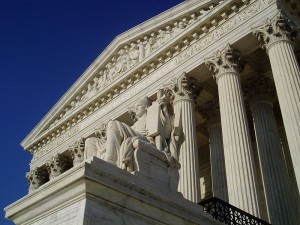In a recent editorial for the Harvard Crimson, Peter M. Bozzo writes a passionate dismissal of the recent Supreme Court decision in Snyder v. Phelps. He argues that the Court’s ruling errs in two respects: “First, it overlooks the difference between restrictions on freedom of speech and restrictions on the how, when, and where of speech. Second, it overlooks the difference between possessing rights and exercising them.” But Bozzo’s rejection of the Court’s opinion pays little attention to law or the facts of the case. While Bozzo may wish to censure the Westboro Baptist Church (WBC), their speech is still protected under the First Amendment regardless of the vile content.
The main problem with Bozzo’s argument, besides his faulty legal logic, is his failure to even properly articulate the basic facts of the case. This is extremely troublesome as the history behind the case is particularly important to the Court’s ultimate decision. Bozzo claims that the case centers on the legality of fining the WBC. In reality it was not a fine that prompted the case, but a lawsuit against the WBC by Albert Snyder, father of the fallen solider whose funeral the Phelps family protested.
The WBC informed the local police of their protesting plans prior to the actual event and complied with all police directions on the protest. In fact, at no point could Snyder actually read the signs as the protesters were on public land 1,000 feet from the funeral’s location behind a temporary fence. These facts clearly contradict Bozzo’s claim that the Court did not acknowledge the ability to restrict the “how, when, and where of speech.” Inappropriate as the context may be for such protests, the WBC was obviously restricted and removed from direct interference of the funeral. Nowhere in the Court’s ruling was the argument that local governments may not pass laws that define certain rules for such protests, but Bozzo overlooks this fact in favor of making a grand (and obvious) statement about the despicable nature of these protests.
Despite the fact that Bozzo cites the Court’s opinion in his editorial, it is clear that he does not fully understand it. Repugnant as the WBC’s protests may be, the First Amendment was designed to protect unpopular speech, particularly of small groups whose voices could be easily silenced by the will of the majority. Disguised by faux-legal rhetoric, Bozzo’s claim is that this unpalatable speech must be stopped. In essence, he argues against the very reason for the First Amendment’s existence.
But, the real question in the Phelps case, in the simplest terms, was not whether the government can make restrictions on freedom of speech, but rather whether the protests of the funeral constituted public or private speech. If one could designate the speech as “private,” involving speech directly aimed at another private individual, then Snyder’s lawsuit and damages from the Church would stand. “Public” speech, however, operates under different standards. As Connick v. Myers (1983) states, “speech on public issues occupies the highest rung of the hierarchy of First Amendment values, and is entitled to special protection.”
This distinction between public and private speech invalidates Bozzo’s second claim that regardless of the WBC’s right to protest, they are still liable for whatever emotional damage it caused. It is here that the finer points of the law come into play. The WBC’s protests were in this case, according to the Court, public speech because the message of the protests was not aimed directly at Snyder or his family, but rather focused on national issues. While the familiar signs of the WBC – which cheerfully state “God Bless 9/11” among a variety of other extremely offensive taglines – are indeed repugnant, they address a larger audience than simply funeral attendees. Because of this “public” message, the Church’s speech is granted full protection under the First Amendment.
I do wonder how Bozzo would have responded to Texas v. Johnson in 1989. There, the Court ruled on yet another controversial type of expression – the burning of the American flag. Flag-burning, like the Westboro protests, inspires strong emotions and disgust in many individuals. But the Court chose to sacrifice popularity and recognize that Johnson’s flag burning was a form of symbolic speech. Would Bozzo have argued that Johnson’s protest against the United States was unconstitutional simply because it offended the public and those who saw the actual flag burning take place?
Ultimately, Bozzo’s editorial is based on emotion rather than sensitivity to the finer points of the law. Few would disagree that the Westboro Baptist Church’s use of their right to free speech is repugnant, but to deny them that right is to deny the importance of the First Amendment. As I wrote in October of last year when the Court heard oral argument for the case, the popularity of the decision is less important than its commitment to protecting the integrity of the Constitution. The Supreme Court’s ruling acknowledged the controversy, but chose the high road in its decision in favor of the Westboro Baptist Church. In the end, it is more important to protect the integrity of the First Amendment than to protect the sensibilities of the American public.
Photo Credit: Wikimedia Commons
